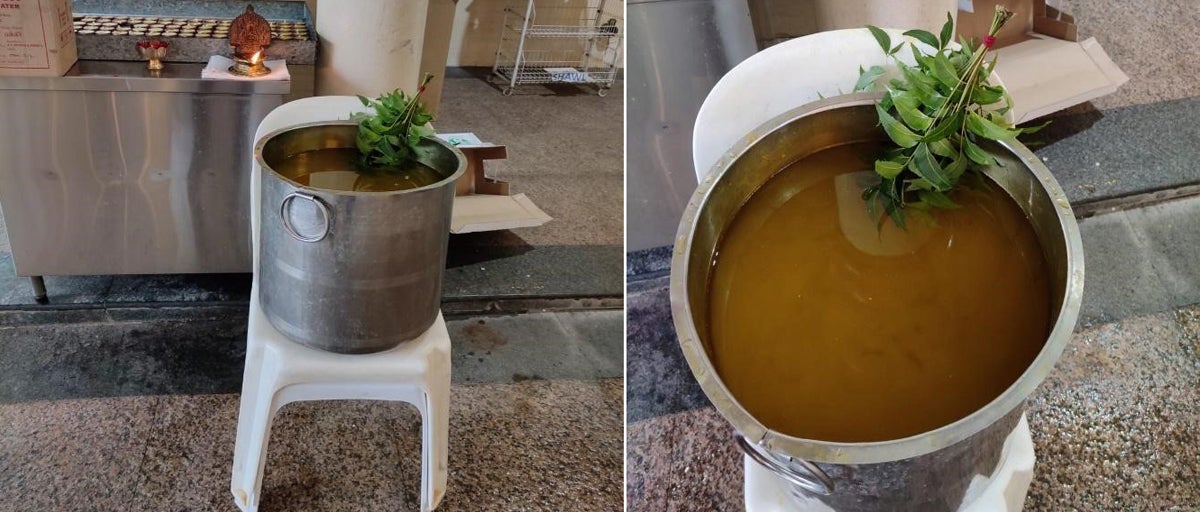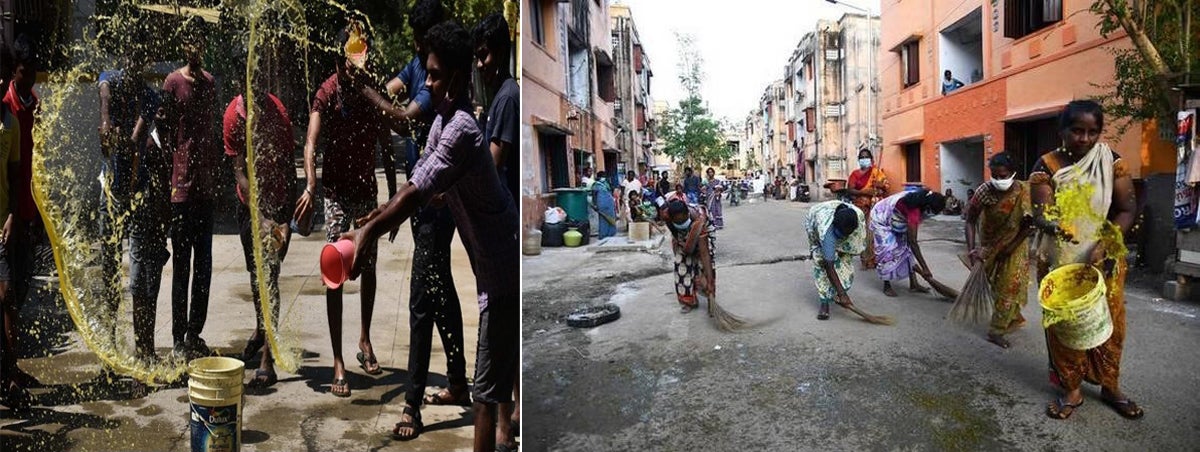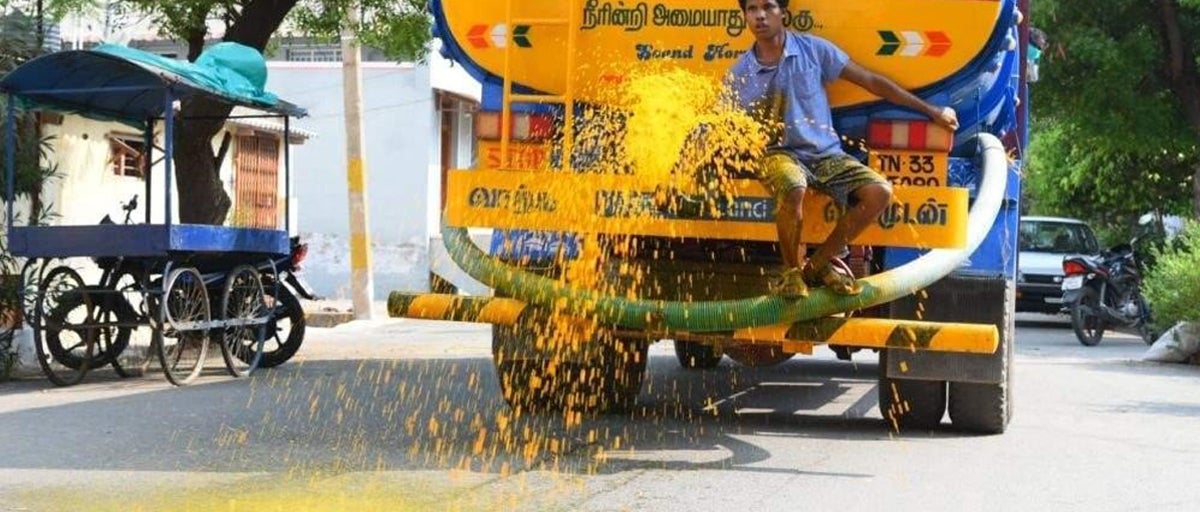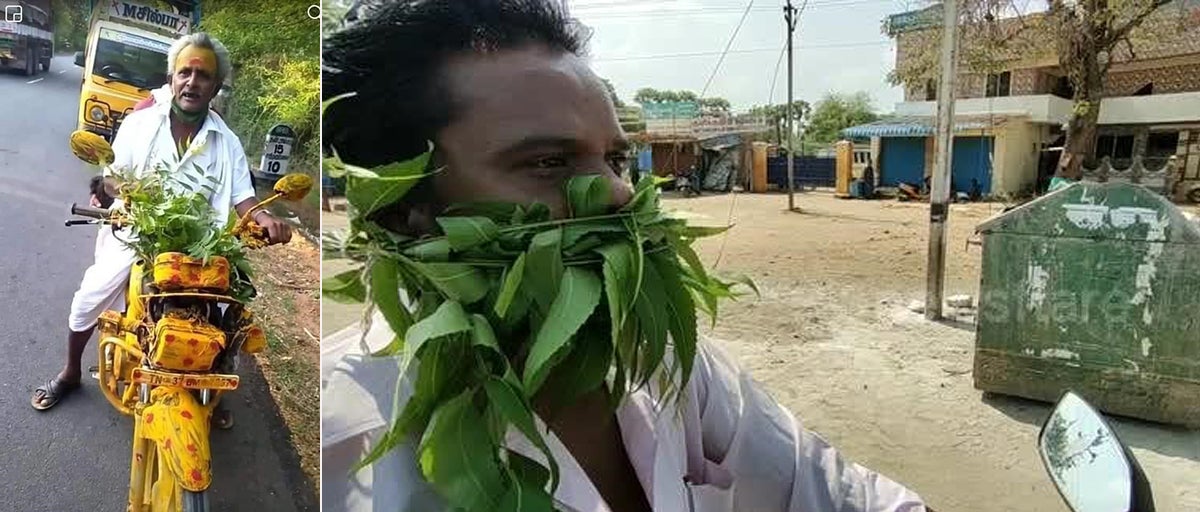Turmeric and Neem: Sacred Herbs, Disease Goddesses and Grappling with Epidemics in Popular Hinduism
contributed by Indira Arumugam, 22 July 2020
Today, there are over 50000 cases of COVID-19 in Singapore and counting. In mid-February 2020 however, the virus was still gathering force. Two major clusters had been found in two church premises. Suspending their live masses, churches had closed. Buddhist temples and mosques were also being encouraged to livestream their services.
For the moment, Hindu temples remained open although the priests were being enjoined not to apply holy ash to devotees’ foreheads. At that time, huge vessels made an appearance at the entrance to Hindu temples such as the Mariamman Temple in Chinatown.

Figs 1&2: Turmeric Water and Neem Leaves Sprinkler, Mariamman Temple Entrance, Singapore, Feb 2020. Credit: Saravana Prakash Rajendran, Author’s Husband
Filled with turmeric-powder infused water, some neem leaves had also been floated in it. Additionally, a bunch of neem leaves was placed alongside so that it could be dipped into the turmeric water and the droplets be sprinkled on one’s head and body as one entered or left the temple.
Turmeric and Neem: Antiseptic Herbs, Prophylactic Powers
As the virus took root in Tamil Nadu, turmeric and neem also made repeated appearances. Along with, if not more than, handwashing, disinfectants and masks, turmeric and neem featured heavily in people’s efforts to clean their surroundings and protect themselves from infection. The photographs from Tamil Nadu that I appended were disseminated through newspaper articles, internet memes, Twitter accounts and WhatsApp messages.

Fig 3: Neem Garlands across window, Chennai, Tamil Nadu, June 2020. Credit: R. Satish Babu

Fig 4: Spraying turmeric water as precautionary measure, April 2020. Credit: EPS/ P. Jawahar
Fig 5: Cleaning the streets with turmeric water, Chennai, Tamil Nadu, June 2020. Credit: M. Karunakaran

Fig 6: Preventive measures with turmeric water, Erode, Tamil Nadu, March 2020. Credit Unknown, Source: Thinamani

Figs 7, 8: Virus prevention with Neem leaves on a government bus, Coimbatore, Tamil Nadu, Mar 2020. Credit: Unknown, Source: Twitter

Fig 9: Neem and Tulsi (holy basil) leaves and masked bus driver, Coimbatore, Tamil Nadu, Mar, 2020. Credit: Unknown, Source: Twitter

Figs 10, 11: Washing with Turmeric-Neem Leaves in Nellai, Tami Nadu, March 2020. Credit: Unknown, Source: News18 Tamil

Fig 12: Protection with Neem and Turmeric, Tamil Nadu, May, 2020. Credit: Unknown, Source: WhatsApp
Fig 13: No Surgical Masks, Home-made Neem Mask, Ramnathapuram, Tamil Nadu. Credit Unknown, Source: Newsflare
Why do turmeric and neem feature so readily and repeatedly in ordinary people’s everyday responses to COVID-19? What is the relationship between these herbs, ritual practices and remedies? How are these plants part of Tamil Hindu aetiologies of epidemic diseases? To answer these questions requires understanding three things, namely:
- The attributes and value of turmeric roots and neem leaves, not only in Tamil ethno-pharmacology, but also in Hindu theologies and rituals.
- The framing of viral, epidemic diseases in Tamil Hindu imaginaries, specifically with reference to the socio-thermal idioms of ‘heaty’ and ‘cooling’.
- The interactions between disease and divinity, especially the relations between mother goddesses (specifically Mariamman), materializations of divine presence and medicine.
Turmeric (Curcuma Longa) is a perennial rhizomatous, herbaceous flowering plant native to South and Southeast Asia.
Neem (Azadirachta Indica), native to the Indian subcontinent, is an evergreen tree with extremely bitter leaves.

Fig 14: Turmeric Plants and Rhizomes
Fig 15: Neem Leaves
‘Heaty’ and ‘Cooling’: Socio-Thermal Idioms of Viral Diseases
In ethno-medical traditions such as Siddha and Ayurveda, parts of and products from both these plants are highly valued for their antiseptic properties. In popular home remedies, pastes made from turmeric and neem are used to soothe the irritations and relieve the itching of chicken pox and lessen post-pox scars. This is drawn from understanding of turmeric and neem as ‘cooling’.
Given the scorching heat of the Tamil Nadu plains for most of the year, coolness is the most desired attribute and reserved as the highest of praise in Tamil poetics. Heat, however, is unwelcome and shunned. This socio-thermal idiom applies to epidemic diseases too.
Diseases such as the now eradicated smallpox and cholera, as well as the still remaining measles, mumps and chickenpox usually strike in the hot summer months. Along with this seasonal incidence, their symptoms of fever, swelling, red rashes and erupting pustules can perhaps explain why these diseases are imagined and described as ‘heaty’. In reference to epidemic diseases, this dynamic of cooling and heaty also draws from theologies of divine temperament, especially presence.
Sacred Trees, Divine Herbs: Embodying the Goddess
Before we delve deeper, we must note that turmeric and neem are used to embody divine presence which underlines their framing as sacred herbs.

Fig 16: Living Neem Tree, Turmeric Complexion and Embodied Goddess. Credit: Mariska Ma Veepilaikaliyamma, Source: Pinterest
Turmeric and neem are commonly seen in ritual offerings made to the goddess. More significantly, the goddess herself is made tangible in the human world through these two plants, especially the neem. When devotees embody the goddess for and during rituals, they form her body by installing bunches of neem leaves in a pot of water (karagam). While these are further embellished with flowers and ornaments, the goddess’s ‘skeleton’ is the pot, water and the neem leaves. Some thriving neem trees themselves, in parts of Tamil Nadu, are perceived and understood to be the goddess in her natural and living form.
Unlike human-built temples and artisan-carved icons, these aniconic embodiments are the goddess wilfully and autonomously manifesting herself (suyambu) in the world. To denote the goddess’s botanically embodied form, the tree may be coloured with turmeric powder. While the turmeric forms her complexion, the neem tree itself is both her temple and the goddess’s own body. Mediating between nature and ritual, as well as the material and spiritual, neem and turmeric personify the goddess as a material and living entity. Next, we turn to the Tamil virus goddess herself.
Mariamman (Mother Goddess): Sacred Disease, Divine Presence
Mariamman is a goddess worshipped in Tamil Nadu villages. She arrived and settled in Southeast Asia with her migrant devotees from the 17thC CE onwards. Like all mother goddesses, she mediates between life and death, fertility and sterility, health and disease as well as fury and serenity. Amman means mother/goddess and Mari means rain. Dampening summer’s scorching heat with the cooling rains she augurs, Mariamman is seen as similarly dispelling fierce viral diseases with her healing touch. Simultaneously however, her presence itself (and her fiery anger) is thought responsible for these diseases in the first place.
Ammai refers to the pustules or ‘pearls of poxes’ and to mother/ goddess. To suffer from Ammai means that the goddess has arrived in the person. In Tamil aetiologies of epidemic diseases, the associations between Mariamman and the pox take three forms, as explained below:
- The goddess is responsible for the ailment’s occurrence.
- The disease (specifically the pustules) and the goddess are one and the same.
- The goddess has the power to alleviate the ailment.
Therefore, given that the goddess is the cause, the condition itself and the cure, pox-diseases are framed as a problem of her presence, temperament and power.
As an embodiment of Mariamman’s presence, the afflicted person is not just sacred but they are the goddess herself. This is why people are wary of allopathic interventions which means preventing or disrupting the goddess’s presence. As my father insisted when he refused the doctor’s offer of a vaccine to truncate my own chicken pox,
“Ammai means Amman is visiting and is staying in your body. If we prevent her from coming or curtail her stay through these medicines … If we go against her will, the goddess might become even angrier. The disease may become more virulent. Better to wait, until she decides to leave on her own.”
Mariamman arrives and inhabits a body as pox for three reasons:
- She is simply playing. The disease is her sport.
- She is testing the depth of her devotee’s devotion only to reward them greatly if they prove worthy. The disease is a sign of her grace.
- She is angry as a result of ritual or moral lapses. The disease is a punishment in order to discipline.
So, it is not simply a matter of her fury manifesting itself as heat and disease. Her very being is akin to fire. Her sacrality is unbearable when having to be borne by mere mortals. Even if she arrives in jest or as love, she is simply too much for humans to grasp or even begin to grapple with. Her presence itself is pain; in and for humans.
‘Heaty’ Goddess, ‘Cooling’ Reverence
The only way to get through the disease is to wait until Mariamman decides to leave of her own volition. All one can do is persuade her to “descend” from the afflicted at the earliest; to cajole and gently so. Hence, the attempts have to be made to cool her and staunch her fire. To cool is to please. Cooling efforts involve treating the afflicted person as the goddess and giving her her due respect.
All the habits that are offensive to the goddess in terms of personal grooming (bathing or combing the hair), diet and cooking methods (non-vegetarian food and oil to sauté or deep fry) and deportment (sex, boisterous conduct and vociferous discourse) – are prohibited. Oily, spicy and heavily seasoned food that may further inflame the condition are avoided. Patients are fanned with neem leaves to cool them. To warn of others of the affliction and to filter and cool the air that comes into the house, bunches of neem leaves are hung outside the patient’s house. In addition, patients are fed cooling foods like young coconut water, yoghurt and saffron. Professionals are engaged to sing lullabies and praise songs to the goddess in the afflicted body. Last but not least, applying turmeric and neem leaf pastes are integral to such cooling efforts. Praised, pleased, cooled and calmed – the goddess then deigns to leave. The disease relaxes its grip and the person recovers.
After their pustules have dried up, the sufferer is allowed to bathe for the first time since the illness’s onset. Termed “cleansing with water” (tanni-potutal), turmeric and neem leaves are mixed into water and poured over the recovered patient. This herb bath is repeated twice more. When the Amman is about to depart, she must be sent on her way with all due respect lest she be angered and return with a vengeance. Therefore people make feast-offerings and worship both at home and in a nearby Amman temple to complete the recovery process.
Possession by Amman through epidemic disease is a provisional apotheosis. However, it can become a permanent one if the sufferer succumbs to pox-diseases. Such a patient dying is termed Ammai /Amma Kulirntuta (the disease/goddess has cooled). As mentioned above, coolness is the remedy for this heaty disease. However, warmth is also body, blood, breath and life. Death is and also brings the cold.
Patients who die from pox-afflictions or divine diseases, are never cremated as per orthodox Hindu customs. Such deceased are not mere corpses. Rather than completely perished, they are seen to be in suspended animation. They are not even simply sacred. They are the goddess herself.
Re-heating the body, through cremation might reignite the goddess’s wrath, which in turn may rebound onto the surviving kin. Instead, they are buried. Their burial sites have the potential to develop into new shrines, temples and ritual cults. Their cooling into death creates new iterations of the goddess. By dying due to Ammai, they too become Amman.
Conclusion
Neem and turmeric have been material entities through which to meditate upon how virulent epidemic diseases have been framed within Tamil Hindu imaginaries. When there had been limited access to allopathic interventions, the depredations of such diseases had been rampant. With widespread vaccinations, smallpox and cholera have been eradicated. With these diseases tamed, epidemic goddesses found themselves alienated from their original and constitutive function.
Today, allopathic interventions are at the forefront of efforts to eradicate the COVID-19 pandemic. Nevertheless, for ordinary people, familiar vernacular idioms and mediums are also part of these efforts. The prophylactic claims of these ancient medicines have not been verified. Nevertheless, the recruitment of primal goddesses to combat a modern disease resonates with a sense of awe and terror at the power of such epidemics to emerge so suddenly, spread so quickly, devastate so extensively and disappear seemingly mysteriously.
At their heart is the unhappy recognition that for all of our advancements, vitality and mortality are not really within our control and remain ultimately a mystery. Puncturing our hubris, is the realization that we do not actually govern the essential conditions of our life. Epidemic goddesses are an expression of society’s lack of power in the face of natural catastrophes, that is ‘acts of god(dess)’; of our own helplessness.
Indira Arumugam is an Assistant Professor at the Department of Sociology, National University of Singapore. An anthropologist, working in Tamil Nadu, India and among the Tamil diaspora in Singapore, her research interests include ritual theories, political theologies and material religion. She has published extensively on the gift, animal sacrifice, kinship and pleasure.
Disclaimer: The views and opinions expressed in this article are those of the authors and do not necessarily reflect the position of the blog editorial team or the Asia Research Institute.
South Asia | Southeast Asia | East Asia | Other Places | Hinduism | Buddhism | Islam | Christianity | Other Religions



